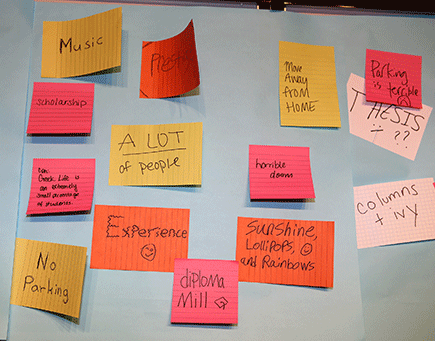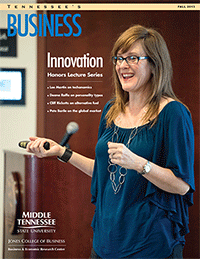Design Thinking
|
As businesses adapt to changing technologies and demographics, the IDEO process of problem identification, grounded in the design process and the behavioral sciences, provides users a decisive edge.
IDEO CEO Tim Brown illustrated how design thinking can be used to imagine 1) the future, 2) new strategies, products, and services, 3) new business models, 4) new applications for technology, and 5) ways to connect to new customers (2008). By triangulating people (with their desires) and business (with need for viability) and technology (with constantly changing feasibilities), design-thinking interdisciplinary teams generate contrasting perspectives through real-world experience. Brown's Change by Design (2009) summarized a number of innovations generated from this approach. Design thinking simplifies the design development process into three phases: inspiration-ideation-implementation. Inspiration is the investigation period, when problems are studied from various perspectives in context. Inspiration relies on the critical ability to empathize with people as they deal with problems. Team members should immerse themselves in the environment. Another process is to observe analogous situations (participating in a NASCAR pit crew to understand the need for speed and accuracy) and apply the experiences to understand other stressful work environments (hospital operating rooms)
Considering all perspectives can lead to innovations. In childhood, we learn stories about world-changing ideas such as Newton discovering gravity when an apple fell on his head. The history of science includes many illustrations of how great inventions were visualized after seemingly unrelated observations. Ideation involves recording and evaluating various perspectives to generate common issues and factors that make a difference. In the global marketplace, this type of knowledge requires significant input from different sources. Historically, in smaller local contexts, successful businesses provided targeted products for clients based on acquired insider knowledge. IDEO multidisciplinary teams gather to post ideas, observations, and conflicts visually for group discussion Implementation is the process of model building or prototyping, testing, producing, and evaluating the user in context. Prototypes can be simple models to generate ideas and solutions. Innovation is dependent on the ability to invest in the problem as a group and to learn from success and failure. The key to promoting IDEO ideas, products, and paradigm changes is the ability to tell the story to educate the audience with a reframed message. The goal is to involve the audience and create a valid sense of empathy to understand the problem in context and the strength of the solution. Empathy is a key component in any design or problem-solving process. As an interior designer and human scientist, my degrees are based in the tenets of business, systems thinking, behavioral sciences, and the design process. A core component of my professional design work was understanding the client in context. I teach a course applying the design-thinking tenets to identify issues and problems for real-world clients. The interior design program is working with the Tennessee State Parks system to evaluate conference centers. Students spend the night to evaluate user experiences, recording observations in break-out sessions. Since today’s students are tomorrow's park patrons, design changes that attract their continued support are important. Students benefit from learning to empathize with different users and contexts. [back to: Innovation and Design]* Janis Brickey is an associate professor of interior design in MTSU's Department of Human Science, College of Behavioral and Health Sciences. |
|
 Student outputs of brainstorming session (photo by Georgia Dennis)
Student outputs of brainstorming session (photo by Georgia Dennis)
